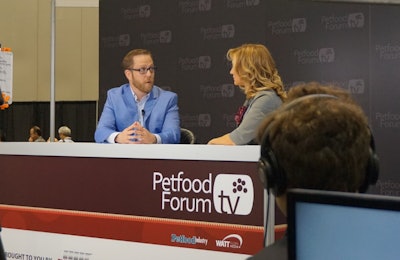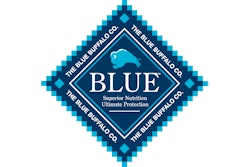
In a highly competitive, regulated marketplace, bringing a new product to market is no easy feat. The road from concept to completion is long, complex and full of speed bumps.
On April 19, Dr. Ryan Yamka, senior vice president of research and development, quality assurance and regulatory affairs at Connecticut-based specialty pet food maker Blue Buffalo Co. Ltd. shared his advice for bringing a product from the drawing board to the feeding dish. Yamka spoke as part of Petfood Forum in Kansas City, Missouri, USA.
The purpose of developing new products
Yamka said several motivations – strategic positioning, differentiation, expansion of an existing product portfolio or even imitation – can push companies to develop new products.
Companies creating a new product as part of a larger strategy must develop something that allows the company to enter a new space, incrementally grow business instead of cannibalizing an existing portion of the market, and position the company as a leader in the space, rather than an imitator of a rival company.
The concept stage
Once a company has decided to develop a new product, it must pool the resources of its management, research and development, and marketing teams to figure out what purpose the product will serve, where it will fit in the market, and what features it will offer.
To successfully navigate the concept stage, companies must be able to think big and willing to consider a failure, which happens when trying new things, as a learning opportunity. Project leaders should remember that no idea or concept is a bad one during the brainstorming phase. Conversely, leadership cannot become married to an idea and dismiss constructive or challenging input. Yamka offered an important caveat that the role of the devil’s advocate, a contrarian or a pessimist, should be minimized during conceptualization.
At the same time, the conceptualization must consider the reality of the company and the market. Leaders should ask themselves what the financial end goal of the product is, if the company has the resources to deliver on the project, and how long it will take to make it a reality. While the limitations of current production capabilities should be considered, they shouldn’t be used as an excuse to abandon the concept.
Feasibility
After refining the concept, project leaders must ask themselves if making the product on a large scale is possible. The product must meet a need in the market, and the company must possess the technology and resources to produce it in large volumes and sell it at a price consumers are willing to pay. They must also consider if the potential product’s formulation of ingredients are approved by regulatory agencies – the U.S. Food and Drug Administration and the Association of American Feed Control Officials – and stable enough to survive production, packaging and storage.
This stage is full of pitfalls, Yamka warned. Internal excitement, driven by management, marketing and research and development, can hurry a project along too fast or cause legitimate concerns about the product’s viability to be ignored. He said pet food companies must avoid insufficient or biased focus group testing; overly optimistic expectations about product capabilities or sales; unrealistic timelines for product development, and unrealistic expectations about the availability of money to finance the project launch and the amount necessary to get the product in stores.
Yamka said regulatory and legal staff should be brought into the discussion as early as possible, especially if label claims will be made on the product and any new ingredients are being introduced to the formula. He advised the audience of pet food professionals to pay attention to these red flags and manage expectations of management. Most importantly, negative results should not be feared, he said, as they can lead to another, better idea.
Product development
Actually formulating the product and producing it is a complex process that requires thorough analysis of the formula, how the product is manufactured, and if it is palatable at the end.
Adding a performance claim to the package creates significant challenges and, in some cases, requires clinical trials and approval from the FDA. Specifically, the FDA views certain label claims as “drug claims” – such as a claim that a product reduces urine pH or hairball formulation or that it cures, treats or prevents a disease – and requires approval before the claim is listed on product packaging. Yamka said some pet food companies will list certain attributes on their websites, and if the website is displayed prominently on the project packaging, the FDA will consider it a label claim and scrutinize the content of the website.
Again, pet food manufacturers need to manage their expectations for product timelines, how much risk will be involved in launching the new product, and how much putting it on the shelf will cost, Yamka said. Manufacturers must also avoid scope creep, or stay focused on what specifically they want their pet food to do, and avoid overanalyzing and unnecessary study of the product. At the same time, they must not ignore red flags or be overly frustrated when research doesn’t go as expected.
Commercialization
After product formula is tested and approved, pet food companies must make a final assessment of the product’s ability to succeed on the pet food market. Manufacturers need to consider how quickly they can scale up production, if the product can be consistently produced, if products in the first batch and the hundredth batch have the same nutritional content and if sales orders can be filled before the product hits the market.
Yamka said the commercialization phase is fraught with obstacles as well. Issues with ingredient sizes, their ability to blend into a formula and function under large-scale extrusion can hamper manufacturing. Sometimes products don’t have the same quality in large batches as they did in small batches due to manufacturing issues. He warned pet food professionals to ask themselves before launch if the product still fills a niche in the market, if it can be sold at a profit, and if consumers will actually pick their product out of the crowded pet food aisle.
Launch
Now that the product is ready for prime time, the work is not over. Yamka said pet food manufacturers need to focus on four key factors: consumer education, shelf space at retailers, product marketing, and what the product’s long-term future looks like. Consumers must be educated on why the product is different from competitors and how it works. The correct retailer must be identified. The correct marketing channel – meetings, trade shows, digital or print advertising – must be identified and a strategy must be in place to keep the product relevant over the long term.
Yamka said pet food companies need to ask themselves who they are communicating with – pet owners, veterinarians or retailers – and how they are promoting their product. There is no greater waste of resources, he said, than spending time and effort putting a product on a shelf only to see it go unsold. Pet food companies must also consider their product’s place in the market over the long term and how long the product will stay relevant to consumers. To maximize a product’s life cycle, a strategy must be in place to keep the product relevant for years to come.

















